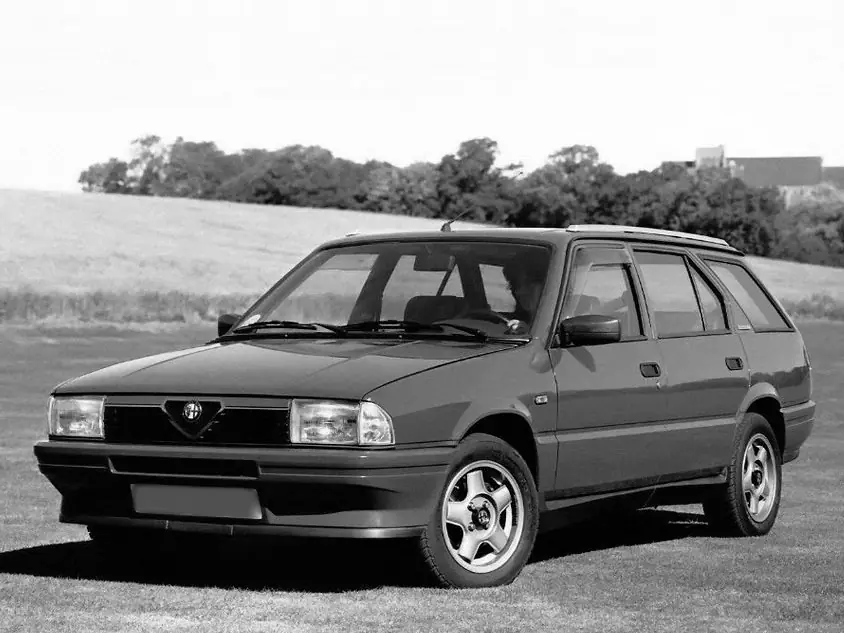The late 1980s marked a transformative period for Alfa Romeo, and the 33 (905) station wagon embodied this transformation perfectly. Launched in September 1986, this reworked family hauler challenged the notion that practical cars must be boring. The 905 series wasn’t just another refresh – it represented Alfa’s commitment to combining daily usability with driving pleasure.
Built upon the success of its predecessor, the Alfasud, the 33 station wagon carved its own niche in the market. While other manufacturers focused solely on utility, Alfa Romeo dared to inject their trademark sporting DNA into a family car, creating something truly special for the discerning driver who refused to surrender to mundane transportation.
Italian Heritage Meets Practicality
The 1986 facelift brought the 33’s design firmly into the modern era. Gone were the angular edges of the original, replaced by smoother surfaces and a more cohesive design language. The revised front end, with its updated grille and headlights, gave the car a more sophisticated presence, while the station wagon’s clean lines managed to look both elegant and purposeful.
The exterior refinements weren’t just cosmetic – they served to modernize the car’s aerodynamics and functionality. The redesigned bumpers and rear section enhanced both looks and practicality, proving that style and substance could coexist.
“My ’88 33 station wagon still turns heads today. There’s something timeless about its design that modern cars just can’t match. It’s the perfect blend of beauty and utility.” – Marco Rossi, vintage Alfa enthusiast
The attention to detail extended beyond the obvious. The way the rear pillars smoothly integrated into the roofline, the subtle wheel arch flares, and the distinctive Alfa Romeo grille all contributed to a design that looked expensive without being flashy.
Even today, the 33 station wagon’s proportions remain remarkably well-balanced. It’s a testament to the designers who managed to add cargo space without compromising the car’s athletic stance.
Power and Performance
Under the hood, the 33 (905) offered a range of engines that delivered true Alfa Romeo character. Here’s what made the powertrain special:
- precise 1.5-liter boxer engine producing 105 horsepower;
- innovative 4×4 system providing exceptional grip;
- responsive 5-speed manual transmission;
- balanced weight distribution for improved handling;
- efficient fuel injection system for better response and economy.
The 1.5-liter boxer engine deserves special mention. While 105 horsepower might not sound impressive today, the engine’s flat configuration gave the car a lower center of gravity, contributing to its excellent handling characteristics. The car could sprint to 60 mph in 12.4 seconds – respectable figures for a practical wagon of its era.
“After 30 years of driving various cars, my Alfa 33 4×4 remains the most engaging daily driver I’ve owned. The boxer engine’s sound and the way it handles mountain roads is simply magical.” – James Thompson, long-term owner
The optional 4×4 system transformed the 33 from a capable family car into a genuinely versatile all-weather vehicle. This wasn’t just a marketing gimmick – the system provided genuine capability in adverse conditions while maintaining the car’s sporting character.
Daily Driver Experience
In the cabin, the 33 station wagon offered a distinctly Italian interpretation of family car comfort. The driving position was typically Alfa – slightly offset but offering excellent visibility and a connection to the car’s controls that modern vehicles often lack.
The interior space utilization deserves recognition. While external dimensions remained compact, clever packaging provided ample room for five adults and their luggage. Key practicality features include:
- folding rear seats for expanded cargo capacity;
- well-placed storage compartments;
- easily accessible load area;
- comfortable seating for long journeys;
- excellent all-round visibility.
The dashboard layout prioritized the driver, with clear instrumentation and major controls falling naturally to hand. Materials quality, while not luxurious, stood up well to daily use.
Living with the 33
Ownership considerations went beyond the initial purchase. The 33 station wagon proved relatively economical to run, with fuel consumption averaging 7-8 liters per 100km for petrol versions. Maintenance, however, required attention to detail and specialist knowledge.
The real test of any family car is its ability to handle daily life, and here the 33 excelled. The combination of a spacious interior, responsive handling, and reasonable running costs made it a practical choice for its time.
A Unique Proposition
Looking back, the Alfa Romeo 33 (905) station wagon represents something we rarely see today – a practical family car that doesn’t compromise on character. It demonstrated that utility and driving pleasure could coexist in a single package.
The 33’s influence extends beyond its production years. It helped establish the template for sporting wagons, proving that family transportation needn’t be boring. Today, these cars are increasingly appreciated for their blend of practicality and personality.
Pros and Cons
| Advantages | Disadvantages |
|---|---|
| Engaging driving dynamics with responsive handling | Specialized maintenance requirements |
| Distinctive Italian design that ages gracefully | Parts availability can be challenging |
| Practical station wagon body style | Some electrical issues common with age |
| Innovative 4×4 system availability | Higher service costs compared to mainstream rivals |
| Efficient boxer engine design | Rust protection needs regular attention |
| Excellent visibility and ergonomics | Limited dealer network for specialist repairs |
| Strong community support among enthusiasts | Interior materials show wear over time |
The Alfa Romeo 33 (905) station wagon remains a compelling choice for enthusiasts seeking a practical classic with character. While it demands more attention than a typical family car, the rewards of ownership – in terms of driving pleasure and distinctive style – continue to justify its appeal among discerning drivers.

